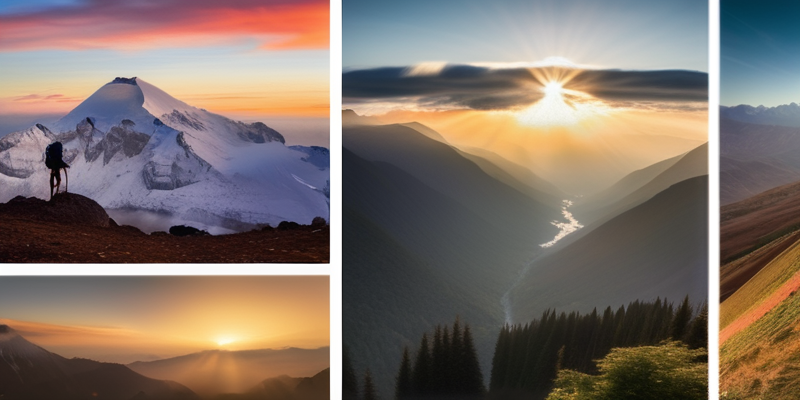Standing at 18,000 feet with nothing but pristine snowfields and jagged peaks surrounding you is an experience that changes you forever. But the journey to these rarefied heights demands more than just physical preparation and mental fortitude—it requires the right equipment designed specifically for the unique challenges of high-altitude environments. High-altitude trekking, typically considered as hiking above 8,000 feet (2,400 meters), presents distinct challenges: temperatures that plummet well below freezing, oxygen levels at a fraction of sea level, harsh UV radiation, and weather that can transform from clear skies to life-threatening storms in minutes. In these environments, your gear isn't just about comfort—it's about survival. This guide will walk you through the essential equipment that experienced mountaineers rely on when venturing into the world's highest places.
Clothing: The Critical Layering System
Marrakech:
The foundation of high-altitude comfort and safety begins with a sophisticated layering system. Unlike casual hiking where a single insulated jacket might suffice, high-altitude trekking demands a strategic approach to managing body temperature and moisture in extreme conditions.
Start with a moisture-wicking base layer made from merino wool or synthetic materials—never cotton, which loses insulating properties when wet and can lead to dangerous heat loss. Your mid-layer should focus on insulation:
down or synthetic fleece provides warmth while remaining breathable during exertion. The outer shell is your critical defense against wind and precipitation; look for jackets and pants with a minimum 20,000mm waterproof rating and fully-taped seams. Many experienced trekkers carry both a hardshell (fully waterproof) and softshell (more breathable) option.
Don't overlook specialized accessories:
a balaclava or buff protects your face from wind and sun, while insulated gloves with waterproof shells prevent frostbite. High-altitude specific socks with graduated compression improve circulation in the cold, and gaiters prevent snow from entering your boots. Remember that temperatures can vary dramatically between day and night, so having options to adjust your insulation is essential for comfort and safety.
Footwear: The Foundation of Your Journey
To truly experience Morocco, dive into its rich culture. Here are some highlights:
Culinary Classes:
Your choice of footwear can make or break a high-altitude expedition. As you ascend, trails transform from dirt paths to rock, snow, and potentially ice—each surface demanding specific performance characteristics from your boots.
Music Festivals:
For treks between 8,000-15,000 feet without technical climbing, choose insulated, waterproof trekking boots with aggressive outsoles. Look for models with ankle support and a semi-rigid shank for stability on uneven terrain. For expeditions above 15,000 feet or those involving glacier travel, consider double boots with removable liners, which allow you to dry the inner boot overnight by keeping it in your sleeping bag. Ensure your boots are compatible with the crampons you'll be using if technical sections are anticipated.
Artisanal Workshops:
Break in your footwear thoroughly before your expedition—this isn't gear you want to test for the first time at altitude. When fitting boots, try them late in the day when your feet are slightly swollen, and wear the socks you plan to use on your trek. Allow extra room for toe movement, as restricted circulation can quickly lead to frostbite in cold conditions. Many experienced mountaineers also pack lightweight camp shoes to give feet a rest at the end of each day.
Technical Equipment: Safety Above the Clouds
Plan your visit around one of Morocco's vibrant festivals to experience the culture at its best:
Marrakech International Film Festival:
Depending on your route, high-altitude trekking may require specialized technical gear that goes beyond what's needed for standard hiking. Understanding and properly using this equipment is crucial for navigating challenging terrain safely.
Fez Festival of World Sacred Music:
For routes crossing glaciers or steep snow, an ice axe becomes essential for self-arrest in case of a fall. Crampons provide crucial traction on icy surfaces, while a climbing harness, carabiners, and knowledge of rope techniques may be necessary for glacier travel or sections requiring protection. A climbing helmet protects against rockfall, which becomes more common as you ascend above the treeline where freeze-thaw cycles loosen stones.
Gnaoua World Music Festival:
Navigation tools take on heightened importance at altitude, where trails may be non-existent and weather can reduce visibility to zero within minutes. Carry a topographic map in a waterproof case, an altimeter watch to track elevation gain, and a compass. While GPS devices and smartphone apps are valuable, always have battery-free backups, as cold temperatures dramatically reduce battery life. For extended expeditions, consider a satellite communication device that allows for weather updates and emergency contact beyond cell service.
Sleeping System: Recovery at Extreme Elevations
Traveling sustainably ensures that Morocco's beauty is preserved for future generations. Here are some tips:
- Quality sleep becomes both more important and more difficult to achieve at high altitudes. Your body works harder in oxygen-depleted environments, making recovery time crucial, while temperatures often drop well below freezing after sunset.
- Your sleeping bag should be rated at least 10-15°F lower than the coldest temperatures you expect to encounter. Down offers the best warmth-to-weight ratio but loses insulating properties when wet; if your trek involves particularly humid conditions, consider a synthetic or treated hydrophobic down bag. Pair your bag with an insulated sleeping pad with an R-value of at least 5 for adequate insulation from the cold ground. Many experienced mountaineers use a closed-cell foam pad beneath an inflatable pad for both puncture insurance and additional insulation.
- Your shelter must withstand extreme conditions including high winds, heavy snow loads, and potentially driving rain or sleet. Four-season tents feature stronger poles, more robust fabrics, and designs that shed snow effectively. Look for models with adequate vestibule space for gear storage and sufficient interior space to prevent condensation from freezing on the inner walls. Position your tent with the entrance away from prevailing winds, and in areas protected from potential rockfall or avalanche paths.
The mountains have a way of humbling even the most prepared adventurers, but having the right gear significantly improves both your safety margins and your enjoyment of these magnificent environments. High-altitude trekking demands respect for the elements and recognition of the specialized equipment needed to thrive in thin air. As you prepare for your next expedition, remember that weight considerations must be balanced against safety requirements—cutting corners on essential gear to save a few ounces could have serious consequences above 8,000 feet. Take time to test all equipment before your journey, understand how each piece functions in cold and challenging conditions, and develop the skills to use technical gear effectively. With proper preparation and the right equipment, the world's highest places offer adventures and perspectives that few ever experience—a rare privilege that rewards those who venture prepared into the realm of clouds and snow.

